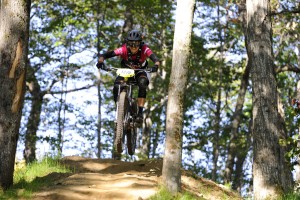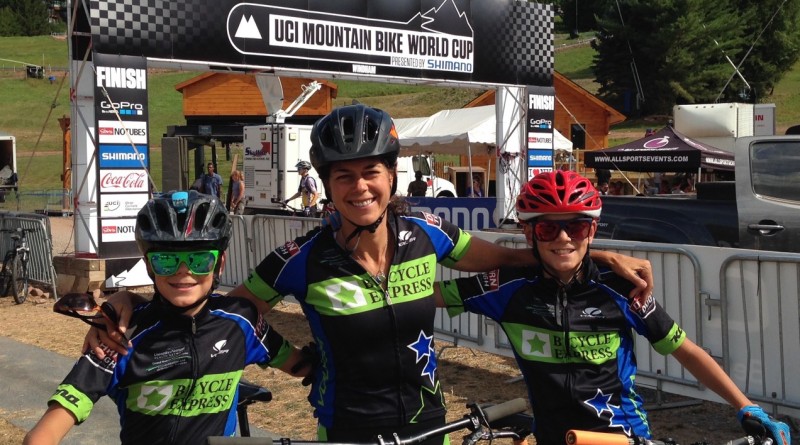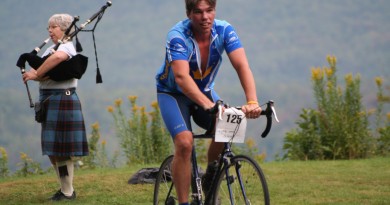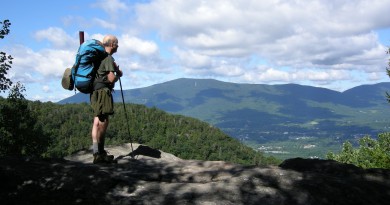The Vermont 50-Mile Test
Champion mountain biker Kelly Ault, her twins Austin and Carson and husband Phil Beard were the subject of our July 2016 cover story, Meet the Dirt P.A.C.K. In this column Ault writes about her experiences at the Vermont 50.
As I rode out of the woods on my mountain bike on September 25th, Mount Ascutney loomed in my peripheral vision. I had been riding for almost six hours. My leg muscles ached from lactic acid and my mental sharpness was beginning to fade. In front of me, two arenas were situated side-by-side in a farm field, each with a horse and a trainer. As I rode past the pens, I became mesmerized by the synchronicity of the animals’ movements as they gracefully circled their masters.
I was less than seven miles from the finish line of the Vermont 50, a 50-mile cross-country endurance event that attracted 1,250 mountain bikers and ultra-runners. The rolling meadows of the horse farm was only one of many drop-dead-gorgeous backdrops along the point-to-point course that had spurred moments of joy that day. Every stand of tall pinewoods, stretch of damp wetland, and patch of pumpkins was 100 percent pure Vermont, as pure as the maple syrup produced in the classic sugarhouses also scattered along the way.
This was the eighth time I’d signed up for this journey, which begins pre-dawn when only a rosy hint of the forthcoming sunrise is visible from the dark hilltops. From the start line in Brownsville, every mile follows gravel and Class 4 roads, singletrack and doubletrack, crossing through four towns and the property of 66 landowners before finishing at Ascutney Mountain Resort.
The Vermont 50 is much more dimensional an experience than taking in Vermont’s autumnal landscape. In fact, the moments of euphoria are more often out-numbered by epic physical and emotional challenges. The course climbs 8,800 feet along rugged trails or windy roads. Rock bridges and root ladders are sprinkled throughout the last third of the course—just about the time the large muscle groups begin to protest and threaten to cramp. The early camaraderie found so easily lessens as riders settle into silent, individualized paces for the long haul. Broken chains, flat tires or crashes dash hopes and downsize expectations.
So, why do so many people show up year-after-year? The motivations are many, as I’ve discovered. In 1998, I signed up like many other goal-setters with the idea that the Vermont 50 would be a late season achievement, one that required dedication over the summer months to ensure enough fitness and technical progression. That year, just finishing the race was a source of pride.

In 2004, training for the Vermont 50 became a months-long journey of another kind. Nine months earlier I had given birth to twin boys, Austin and Carson. That year, the hours of riding I had managed to carve out of the daily demands of motherhood provided much-needed quality time alone. It also sparked a reinvention of myself as an athlete. During the race, I plodded steadily along with presence and determination. When I pulled my children close at the finish line, I felt the balance between generosity towards my family and self-care that has set a tone for me to this day.
In 2012, I simply wanted to win. After a season dedicated to training and racing, I rolled off the start powered by ambition. I didn’t linger at aid stations. I tucked into pods of racers, drafted wheels and charged technical climbs. I found finesse on flowy sections. When I missed a turn five miles shy of the finish, I surprised myself with a caffeinated burst of speed and crossed the line as the first overall woman.
Which brings me to 2016, where the meaning of the Vermont 50 came full circle for me. At age 12, my sons Austin and Carson were now eligible to register. They had been dedicated riders all year, spending winter nights on indoor bike trainers, doing a multitude of arduous four-hour training rides and turning in impressive finishes at 15 cross-country and enduro races around the country this past spring and summer.
Despite their confidence, I had concerns and had arranged to wait for them at an early aid station with snacks and tools. After they came up, we re-joined the line of racers ascending majestic tree-lined roads and descending loamy trails. I felt a mix of elation and connection as we chatted about small things.
But by mile 30, as they steadily pulled ahead together, I realized I could no longer hold their pace. So I let them go. I was sure I wouldn’t see them until the end, but I knew they wanted to go it on their own. They had earned their independence.
Shortly after, at mile 36, I rolled up alongside a good friend. Liza Walker joined other riders that day in making the Vermont 50 a fundraiser for Vermont Adaptive Ski and Sport (VASS). Race director Mike Silverman expects this year’s race to generate close to $80,000 for VASS’ programs.
Liza shared that she was riding for Juno, her 10-year old daughter, who was diagnosed with autism at age 4 and began skiing with VASS’ Sugarbush Resort program at 6. She recalls being incredibly moved when VASS volunteers pledged they would get Juno skiing on her own, “even if it took ten years”.
For kids with disabilities, Liza explained, learning a sport can be a transformative journey towards self-confidence and independence. She described how powerful the process has been for her as a parent in letting go and accepting help from others.
When I reached the finish, the chute was lively with music and spectator cheer. Austin, Carson and my husband, Phil Beard (who also raced) met me with congratulations. The boys had finished 15 minutes ahead of me, with Austin crossing the line 15 seconds in front of Carson. Although I had provided some company at points along the way, their race reports reflected a largely connected experience between each other. Motivation to close or widen the gap between each other had them constantly going for it. For both of them, finishing the distance “felt like a real accomplishment.”
The day after the event, I was nursing muscle soreness and fatigue. But I was buoyed by the diverse people brought together by the Vermont 50—from the ambitious racer striving for a podium finish to the aspiring rider working to achieve a personal goal, from the parent and child navigating an ever-evolving relationship to the VASS volunteers working to make a difference. I’m convinced that VASS’ statement of belief could serve as a universal mantra:
Sports and recreation provide a physical, mental and social experience that is immeasurable in promoting self-confidence and independence in an individual.”
Each of us may have traveled a different path that day, motivated by different purposes. But the uniqueness of the shared experience was palpable.



